Pump Handbook by Igor J. Karassik, Joseph P. Messina, Paul Cooper, Charles C. Heald - 3rd edition
Подождите немного. Документ загружается.

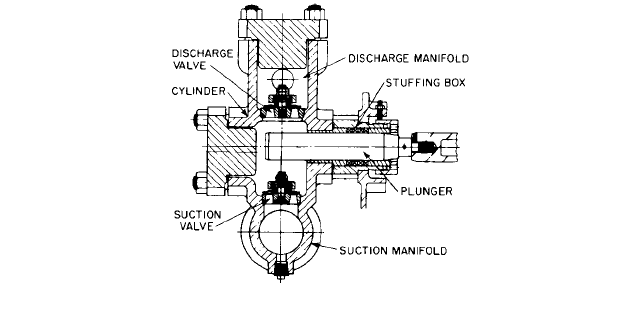
3.22 CHAPTER THREE
FIGURE 1 A liquid-end horizontal pump (Flowserve Corporation)
triplex pumps. Triplex (three cylinder), quintuplex (five cylinder), septuplex (seven cylin-
der), and nonoplex (nine cylinder) pumps have been designed that have over a 90-percent
interchangeability of parts. Only the power frame and crankshaft are unique to a specific
pump size.
Factors of safety are used in power pump design and application. A connecting rod
assembly, for instance, normally has a safety factor in excess of a 3:1 ratio because if a con-
necting rod fails in operation, it normally destroys many other power-end parts. A nodu-
lar iron frame will have a high safety factor also, primarily due to the requirement for
thick wall sections to mount interfacing parts and to reduce operating noise levels. Some
fluid-end expandable parts in the stuffing box and valves have safety factors below a 1.5:1
ratio because these parts are normally replaced before they would fail due to fatigue.
There has been a trend in past years in most industries to purchase power pumps that
operate at higher and higher speeds. This has been driven by the economics of buying
smaller, higher speed equipment versus the older, large, slower speed pumps. This trend
seems to be loosing some momentum, especially in critical applications. It remains for the
pump purchaser and pump supplier to jointly evaluate each application and try to arrive
at a pump selection that will provide the most reliable performance for the lowest installed
cost and operating cost.
LIQUID END _________________________________________________________
The liquid end consists of the cylinder, the plunger or piston, the valves, the stuffing box,
the manifolds, and the access covers. Figure 1 shows the liquid end of a horizontal pump,
and Figure 2 shows the same for a vertical pump.
Cylinder (Working Barrel) The cylinder is the body where the pump pressure to over-
come discharge pressure is developed. It is continuously under fatigue. Cylinders on many
horizontal pumps have suction and discharge manifolds integral with the cylinder. Verti-
cal pumps have separate manifolds.
A cylinder containing the passages for more than one plunger is referred to as a single
cylinder. When the cylinder is used for one plunger, it is called an individual cylinder. Indi-
vidual cylinders are used where developed stresses or replacement costs are high.
Cast cylinders are usually limited to the developed pressures listed in Table 1. Forged
cylinders are made from 1020 and 4140 carbon steel; 304L, 316L, 17-4 PH, and 15-5 PH
stainless steels; and nickel aluminum bronze. In recent years, duplex stainless steels have
seen an increase in usage when higher strength and corrosion resistance is required.
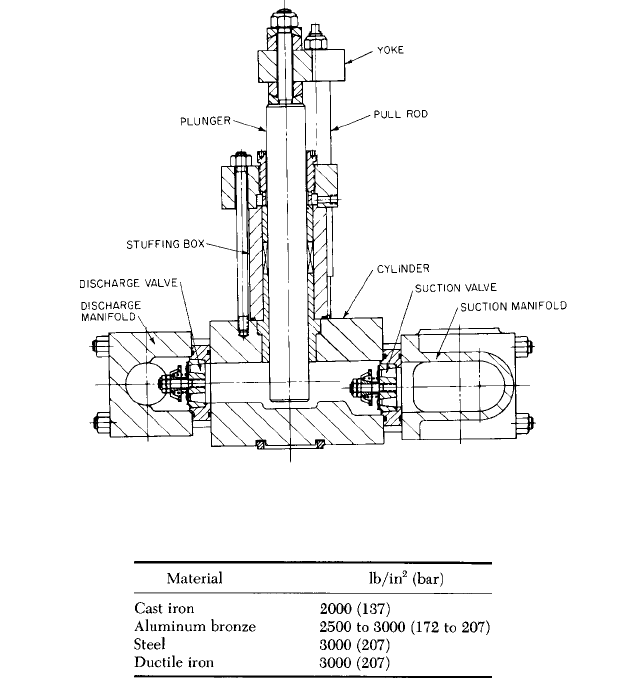
3.2 POWER PUMP DESIGN AND CONSTRUCTION 3.23
FIGURE 2 A liquid-end vertical pump (Flowserve Corporation)
TABLE 1 Maximum pressure in cast cylinders
Forged cylinders have a 4:1 to 6:1 forging reduction on all sides of the cylinder to obtain
a homogeneous internal structure.This type of cylinder requires heat treatment after forg-
ing to eliminate the stresses that occur during the forming operation. The pump designer
must minimize the section thickness of the cylinder or residual stresses may remain after
machining the internal bores.
The highest stresses occur at the intersection of the horizontal and vertical internal
bores. Unlike a simple cylinder where the internal stresses are analyzed as a single hoop
stress, the stress at the intersecting bores of a power pump cylinder are based on a double
hoop stress. In Figures 3 and 4, the distances b and d are the internal diameters, a and c
are the diameters to the nearest obstruction of the solid material of the cylinder, P is the
developed pressure, and S is the resulting stress. Stress concentration factors at the inter-
secting bores can be omitted if the radius is not less than 0.25 in (1.5 mm). Above 3000
lb/in
2
(207 bar), the internal bores should have a surface finish of 63 rms minimum.
During each plunger cycle, the developed pressure goes from suction pressure to dis-
charge pressure and back to suction. For a pump operating at 360 strokes per minute, over
six million fatigue cycles will occur in less than 12 days. For this reason, very conservative
allowable stress limits are used. Normally, these limits range from 10,000 to 25,000 lb/in
2
(69 to 172 Mpa), depending on the material of the cylinder, duty cycle, and liquid being
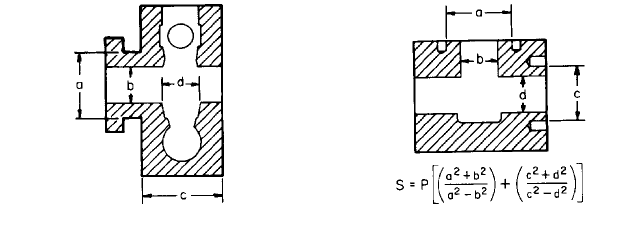
3.24 CHAPTER THREE
FIGURE 3 Stress dimensions for a horizontal
liquid end (Flowserve Corporation)
FIGURE 4 Stress dimensions for a vertical liquid
end (Flowserve Corporation)
pumped. The allowable stress is a function of the fatigue stress of the material for the liq-
uid being pumped and the life cycles required.
Due to improper suction system design, misapplications, or process upsets, instanta-
neous pressure in the cylinder may be much higher than design pressure. When the liq-
uid contains entrained gas that can be released because of inadequate suction pressure,
the resulting cavitation can cause instantaneous pressure four to five times the design
pressure.This results in reducing the life of the cylinder and other liquid-end components,
as well as damaging pressure pulsations in the suction and discharge piping systems.
For continuous duty pumps operating above 10,000 lb/in
2
(690 bar) of discharge pres-
sure, special liquid-end designs have been developed. In Figure 5, the intersecting bores
have been eliminated by arranging the suction and discharge valves on the same axis as
the plunger. This means the stresses in the cylinder will be only half of those in a compa-
rable T-block design.
Plungers The plunger transmits the force that develops the pressure. It is normally a
solid construction of up to 5 in (127 mm) in diameter. Above that dimension, it may be
made hollow to reduce its weight. Small-diameter plungers used for 6000 psi (414 bar)
and above should be reviewed for possible buckling. Plunger speeds range from 150 to 350
fpm (46 to 107 m/s). The surface finish normally is between 14 and 20 rms. A finish below
8 rms should be avoided because excessive packing leakage may occur due to the inabil-
ity of the packing to seal properly on the smooth surface.
Although some plungers are made of heat-treated or case-hardened steel, the most
common are the hard-coated or solid ceramic. The hard coatings are normally flame
sprayed powders of Colmonoy or tungsten carbide, or ceramic oxides. These can be applied
over base materials of 1020 carbon steel or 316L stainless steel. Ceramic oxide is normally
limited to 200°F (93°C) and is used for soft water, crude oil, mild acids, and mild alkalis.
The porosity and bond strength of coatings must be carefully evaluated for use with
higher operating pressures. Under those conditions, the liquid may penetrate the pores of
the coating and lift the coating off the base material. Ceramic plungers also have special
requirements and limitations. This type of plunger is often constructed as a solid bar,
closed-end tube of ceramic, bonded to a metal end cap or plug. A vent must be provided to
allow the pressure inside the plunger to equal the atmospheric pressure or the ceramic-
to-metal bond may fail or the plunger may explode. In addition to the normally fragile
nature of any ceramic plunger, the solid ceramic plunger is susceptible to failure due to
thermal shock.
Pistons Pistons are used for water pressures up to 2000 lb/in
2
(138 bar). For higher pres-
sures, a plunger is usually used. Pistons are cast iron, bronze, or steel with reinforced elas-
tomer sealing rings (see Figure 6).They are most frequently used in duplex, double-acting
pumps. The latest trend is to use pistons in single-acting triplex pumps.
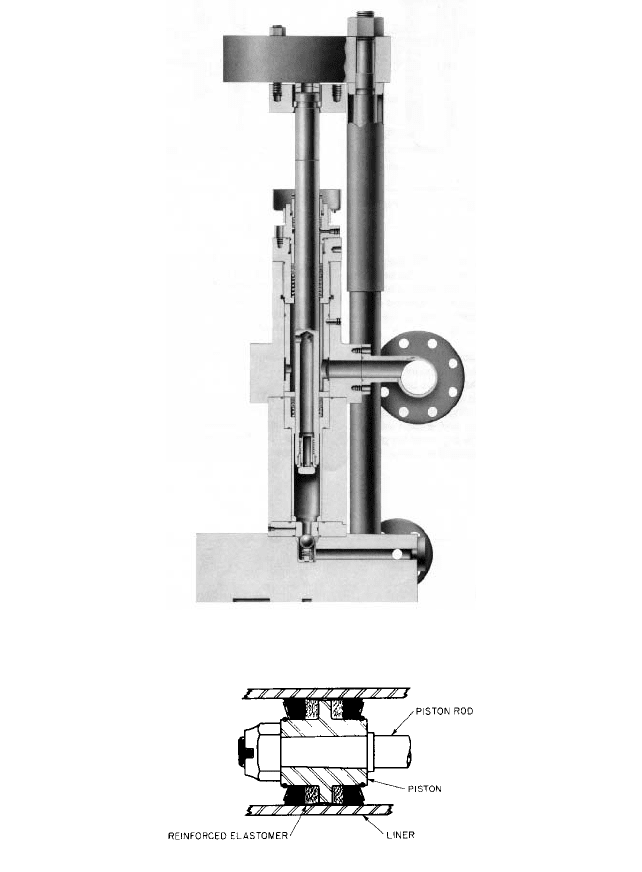
3.2 POWER PUMP DESIGN AND CONSTRUCTION 3.25
FIGURE 5 Special high-pressure liquid-end designs arrange the suction and discharge valves on the same axis
as the plunger, thus eliminating intersecting bores (Flowserve Corporation).
FIGURE 6 Elastomer face piston (FWI)
Stuffing Box The stuffing box assembly consists of a stuffing box, upper and lower bush-
ings, packing, and a gland. For ease of maintenance, the stuffing box assembly is usually
removable (see Figure 7).
The stuffing box bore is machined to a 63 rms finish to ensure packing sealing and life.
A single hoop stress equation is used to determine the wall thickness with an allowable
stress limit of 10,000 to 20,000 lb/in
2
(69 to 138 MPa).
The bushings that guide the plunger have a 63 rms finish with approximately 0.001 to
0.002 in (0.02 to 0.05 mm) of diametrical clearance per inch of the plunger diameter. The
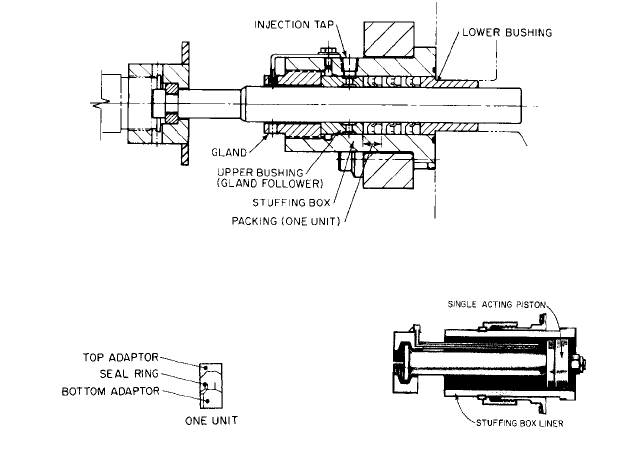
3.26 CHAPTER THREE
FIGURE 7 A stuffing box (Flowserve Corporation)
FIGURE 8 Chevron packing (Flowserve
Corporation)
FIGURE 9 Single-acting piston stuffing box
(Flowserve Corporation)
lower bushing is sometimes secured in an axial position to prevent movement of the pack-
ing. Bushings are made of bearing bronze, Ni-resist, or cast iron. Stainless steel can be
used if its antigalling properties with the plunger coating can be verified.
Packing is either square cross-section, woven construction or molded V or chevron-
shaped (see Figure 8). Some types use metal backup adapters.A packing set consists of top
and bottom adapters and one or more packing sealing rings.A stuffing box can use two to
five rings of packing, depending on the pressure and the fluid being pumped. Packing rings
are usually made up of a number of composite materials selected for their strength, wear
resistance, and lubricity, including neoprene, Teflon, cotton duct, and Kevlar.
Packing can be made self-adjusting by installing a spring between the bottom of the
packing set and the lower bushing or bottom of the stuffing box. This arrangement elimi-
nates overtightening the packing and enables a more uniform break-in. Packing can be
lubricated through a grease fitting or by an auxiliary lubricator driven through a take-off
on the crankshaft.
For chemical or slurry service, a lower injection ring is used for flushing.This prevents
concentrated pumped fluid from impinging directly on the packing. This injection can be
continuous or synchronized to inject only on the suction stroke. Flush glands at the out-
board end of the stuffing box are employed when a toxic vapor is present or when the leak-
age may flash.
The stuffing box for the piston rod of a double-acting pump is similar in construction
to that of a stuffing box for a plunger. The primary difference is that it must seal against
pressure being developed while the rod moves back through the packing. Single-acting pis-
tons do not employ a stuffing box. Leakage past the piston-sealing rings goes into the
frame extension to mix with the continuously circulating lubricant.
Cylinder Liner The cylinder wear liner (refer to Figure 6 and see Figure 9) is usually
of Ni-resist material. Its length is slightly longer than the stroke of the pump to enable
an assembly entrance taper of the piston into the liner. In double-acting pumps, the liner
has packing to prevent leakage from the high-pressure side to the low pressure side of the
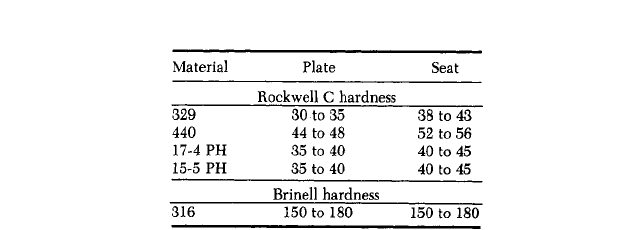
3.2 POWER PUMP DESIGN AND CONSTRUCTION 3.27
TABLE 2 Recommended material
hardness for valve plate and seat
cylinder. Because of the brittleness of the liner, the construction should be such that the
liner is not compressed. The finish of the bore of the liner is approximately 16 rms.
Valves Many types of valve designs exist. Which type is used depends on the applica-
tion. The main parts of a valve assembly are the seat and sealing member, usually a disc,
ball, or plate. The plate movement is controlled by a spring or retainer. The seat usually
uses a taper where it fits into the cylinder or manifold. The taper not only gives a posi-
tive fit but permits easy replacement of the seat.
Some pumps use the same size suction and discharge valve for interchangeability
(refer to Figure 2). Some use larger suction valves than discharge valves for improved
NPSH reasons. Others use larger discharge valves than suction valves because the cylin-
der configuration requires the suction valve to be removed through the location of the dis-
charge valve (refer to Figure 1). Because of space considerations, valves are sometimes
used in clusters on each side of the plunger to obtain the required total valve area that
reduces valve velocity.
Table 2 shows seat and plate hardness for some valve materials. Seats and plates made
of 316 stainless steel material are usually chrome-plated or flame-sprayed to give them
the desired surface hardness.
The flow area of the valve must be large enough to prevent significant pressure drop
or restriction to flow. Normally, suction valves are sized for 6 to 8 ft/s velocity, and the dis-
charge valves and sized for 8 to 12 ft/s.
The valve springs must be made of corrosion-resistant material and designed to with-
stand high-cycle fatigue stresses. Under no situation should the valve operation enable the
spring to go to a solid stack height or wire-to-wire condition. The ends of the spring must
be ground flat and square with a maximum perpendicularity of 3 degrees.
Manifolds These are the chambers where the liquid is disbursed or collected for distri-
bution before or after passing through the cylinder. In horizontal pumps and some verti-
cal pumps, the manifolds are cast or machined integral with the fluid cylinder. Most
vertical pumps have the suction and discharge manifolds separate from the cylinder (refer
to Figure 2).
Suction manifolds are designed to eliminate air pockets from the flange to the valve
entrance (see Figure 10). Separate suction manifolds are cast iron, cast bronze, or fabri-
cated steel. Discharge manifolds are steel forgings or fabricated steel. The manifolds have
a minimum deflection to prevent gasket shifts when subjected to maximum operating
pressures.
The velocity through the manifolds of a clean liquid is 3 to 5 ft/s (0.9 to 1.5 m/s) at the
suction and 6 to 16 ft/s(1.8 to 4.9 m/s) at the discharge. Suction and discharge manifold
velocities in a slurry service are 6 to 10 ft/s (1.8 to 3 m/s). Slurry services have a minimum
velocity of 6 ft/s (1.8 m/s) to prevent the heavier slurry particles from falling out of solution.
In USCS units,
In SI units,
V 1m>s2 pump m
3
>h 277.8>cross-sectional area of the manifold, mm
2
V 1ft>s2 pump gpm 0.321>cross-sectional area of the manifold, in
2
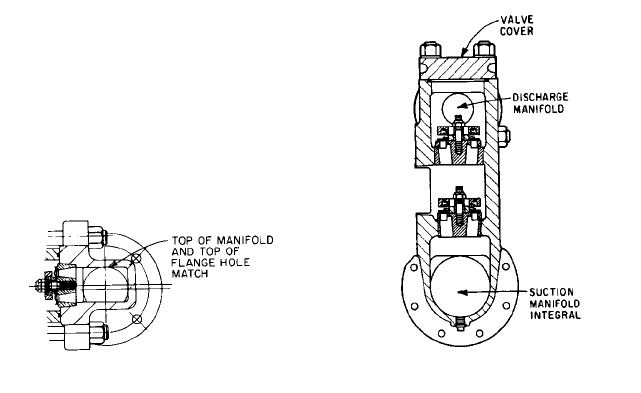
3.28 CHAPTER THREE
FIGURE 10 A suction manifold construction to
eliminate air pockets (Flowserve Corporation)
FIGURE 11 An integral suction and discharge
manifold (Gardner-Denver)
A water hammer creates an additional pressure (which is added to the rated pump
pressure), as does hydraulic shock loading. The discharge manifold rating is then made
equal to or greater than the sum of these pressures.
Valve Covers Valve covers are used to provide accessibility to the valves without dis-
turbing the cylinder, manifold, or related piping (see Figures 11 and 12.
Plunger Covers and/or Cylinder Heads These are used on horizontal pumps to pro-
vide accessibility to the plunger, piston, and cylinder liner (refer to Figures 11 and 12 and
see Figure 13).
POWER END ________________________________________________________
The power end contains the crankshaft, connecting rods, crossheads, pony rod, bearings,
and frame (see Figures 14 and 15). Basic designs are horizontal and vertical with sleeve
or antifriction bearings. Some have integral drive gears.
Frame The frame absorbs the plunger load and torque. Vertical pumps with outboard
packed stuffing boxes (refer to Figure 2) have the frame in compression (refer to Figure
14). With horizontal single-acting pumps, the frame is in tension (refer to Figure 15).
Frames are usually close-grain cast iron with relatively thick cross-sections. This combi-
nation provides superior dampening for the normal low-frequency cyclic loading. Some
intermittent duty pumps, specifically designed for mobile services, are constructed of
lighter weight, fabricated steel plate.
The frame is usually vented to the atmosphere. However, when the atmosphere is
detrimental to the working parts of the frame, such as an ammonia attack on bronze bear-
ings, the frame can be purged continuously with nitrogen gas.
Crankshaft The crankshaft (see Figures 16, 17, and 18) varies in construction, depend-
ing on the design and power output of the pump. In horizontal pumps, the crankshafts
are usually of nodular iron or cast steel. Vertical pumps use forged steel or machined bil-
let crankshafts. Because the crankshafts have a low mass and operate at relatively low
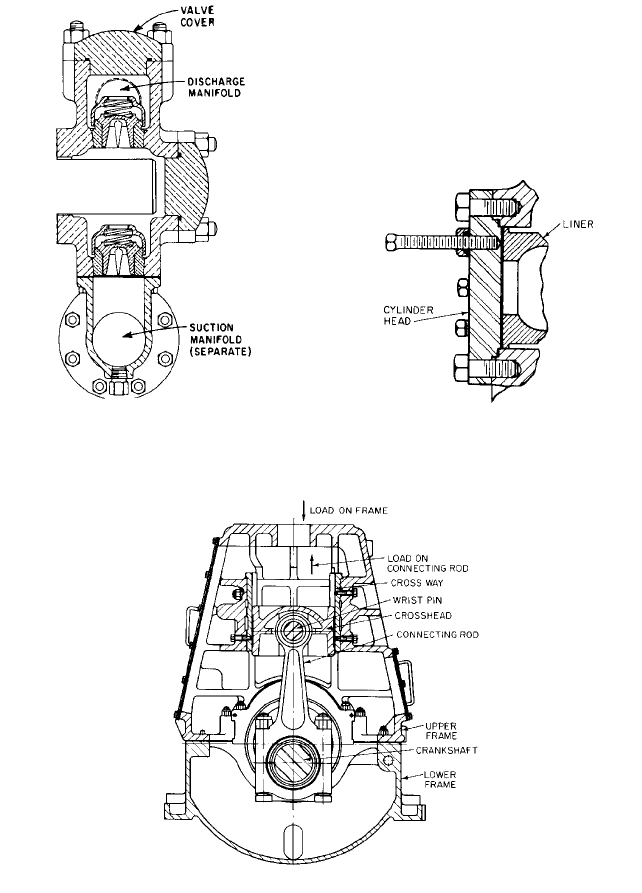
3.2 POWER PUMP DESIGN AND CONSTRUCTION 3.29
FIGURE 12 Separate suction with an integral
discharge manifold (Gardner-Denver)
FIGURE 13 A plunger cover (FWI)
FIGURE 14 A vertical pump power end (Flowserve Corporation)
speeds, counterweights and flywheels are not used. Except for duplex pumps, the crank-
shaft always has an odd number of throws to obtain the best flow pulsation characteris-
tics. The firing order in a revolution depends on the number of throws on the crankshaft
(see Table 3).
The crankshaft main and rod-bearing surfaces are ground to a 16 rms surface finish or
better. Large radii are used where journal diameters intersect with the adjacent cheeks to
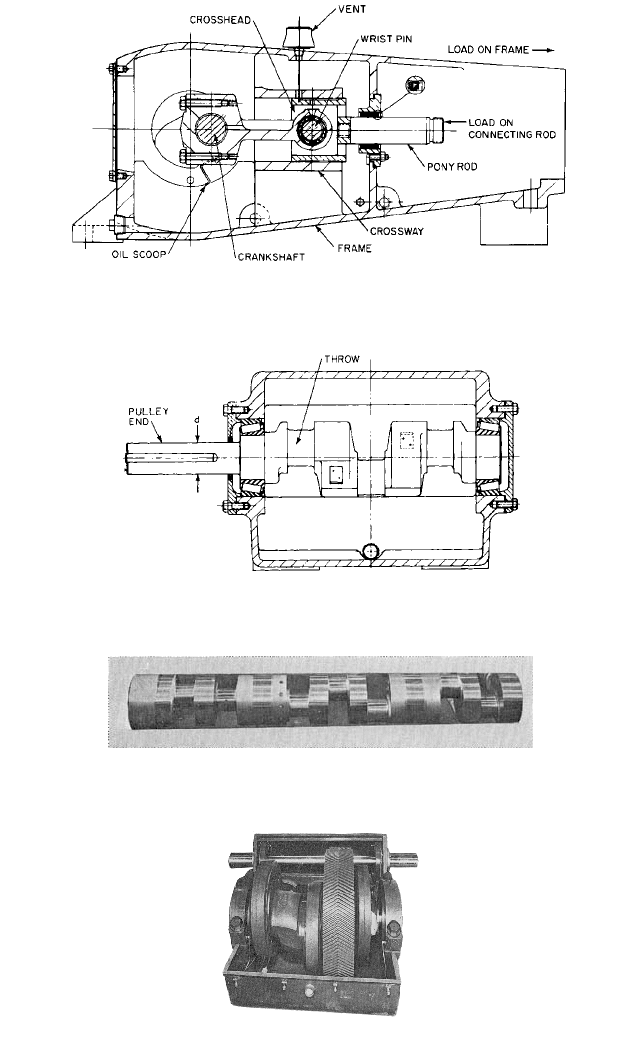
3.30 CHAPTER THREE
FIGURE 15 A horizontal pump power end (Flowserve Corporation)
FIGURE 16 A cast crankshaft (Flowserve Corporation)
FIGURE 17 A crankshaft machined from a billet (Flowserve Corporation)
FIGURE 18 A cast crankshaft with integral gear (Continental-EMSCO)
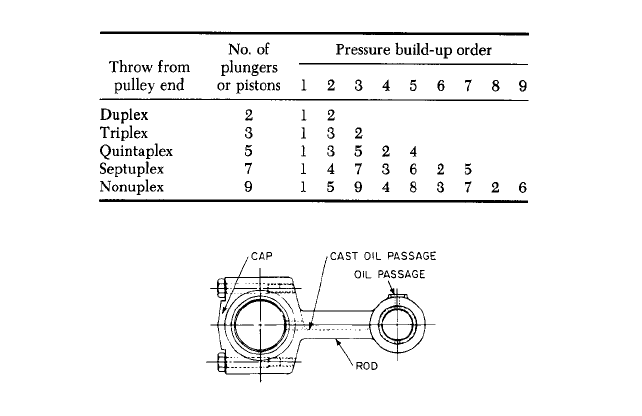
3.2 POWER PUMP DESIGN AND CONSTRUCTION 3.31
TABLE 3 Order of Pressure Build-up or Firing Order
FIGURE 19 The connecting rod (Flowserve Corporation)
minimize stress concentrations in these fatigue-prone areas. Cross-drilling of the main to
rod journals is often provided to furnish lubrication to the crankpin bearings.
Many horizontal pumps under 250 hp (186 kW) are driven by means of a sheave or pul-
ley and belt arrangement. Increasing the diameter of the pulley for a given horsepower
will increase the stress in the crankshaft. The maximum allowable crankshaft stress will
often limit the maximum diameter of the pulley that can be used. Stress levels of 2000 to
3000 lb/in
2
(14 to 20.7 MPa) are common, where d is the pulley end diameter of the crank-
shaft in inches (mm) and n is the pump speed in revolutions per minute.
Connecting Rods and Eccentric Straps The connecting rods (see Figure 19) trans-
fer the rotating force of the crank pin to an oscillating force on the wrist pin. Most con-
necting rods are split perpendicular to their centerline at the crankpin end for ease of
assembly onto the crankshaft.
The cap and rod are aligned with close-tolerance bushings or body-bound bolts. The
rods either are rifle-drilled or have cast passages to transfer oil from the wrist pin to the
crank pin. A connecting rod with a tension load is made of forged steel, cast steel, or fab-
ricated steel. Rods with a compressive loading are cast steel, nodular iron, or aluminum
alloy. The connecting rod finish, where the bearings are mounted, is 32 to 63 rms.
The ratio of the distance between the centerlines of the wrist pin and crank pin bear-
ings to half the length of the stroke is referred to as the L/R. The ratio directly affects the
pressure pulsations, volumetric efficiency, size of the pulsation dampener, speed of liquid
separation, acceleration head, moments of inertia forces, and size of the frame. Low L/R
results in higher fluid pulsations.A high L/R reduces pulsations but may result in a large
and uneconomical power frame. The common industrial L/R range is 4:1 to 6:1.
The eccentric strap (see Figure 20) performs the same function as a connecting rod,
except that the former usually is not split. The eccentric strap is furnished with rolling ele-
ment bearings, whereas connecting rods are furnished with sleeve bearings. Eccentric
straps are applied to mud pumps and some slurry pumps, which are started against a full
load without requiring a bypass line.
Wrist Pin Located in the crosshead, the wrist pin transforms the oscillating motion of
the connecting rod to a reciprocating motion. The maximum stress in the wrist pin from
deflection should not exceed 10,000 lb/in
2
(69 MPa):
